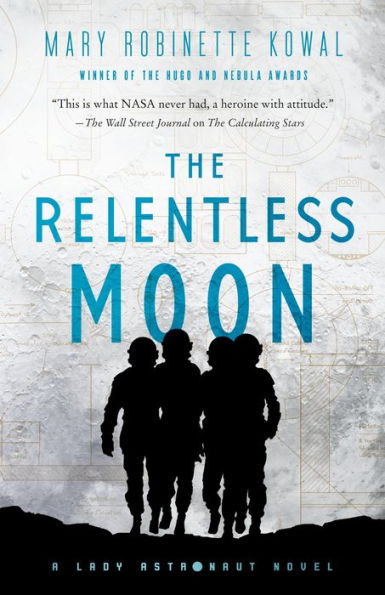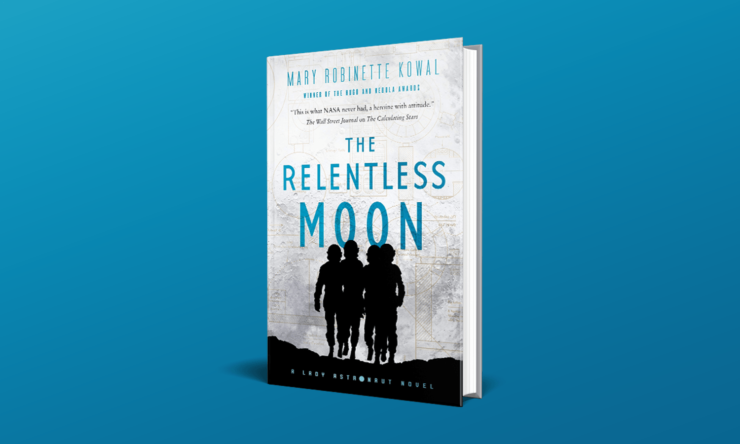Mary Robinette Kowal’s Lady Astronaut series launched with a single novelette (“The Lady Astronaut of Mars“), and the eponymous Lady Astronaut Elma York has in turn inspired other women to go to space in this punch-card-punk alternate history.
While The Calculating Stars and The Fated Sky both traced Elma’s paths from Earth to the Moon and then to Mars, Kowal has expanded the scope of her series by focusing on a new “astronette” for the third installment: ambitious, brilliant senator’s wife and WASP pilot Nicole Wargin, whose adventure on the lunar colony in The Relentless Moon runs parallel to the events of The Fated Sky. In doing so, Kowal reminds readers that humanity has a long way to go to settle the Moon, and that no two Lady Astronauts are alike.
At the same time that Elma is on a history-making three-year mission to Mars, her dear friend and fellow astronette Nicole grapples with present unrest on Earth. It’s been over a decade since the Meteor wiped out most of the Eastern Seaboard, transplanting the seat of government to Kansas City—where Nicole’s husband Kenneth is senator—and refocusing the world’s priority to escaping the increasing effects of climate change. But while the International Aerospace Coalition (IAC) works to establish and expand the lunar colony with new influxes of civilians and astronauts, the growing Earth First movement resists the narrative of leaving their planet… especially because it is clear that not every single human can afford (money- or health-wise) to go to the stars.
While past Lady Astronaut novels have explored the political challenges of resettling the human race, The Relentless Moon best embodies these obstacles in the tenacious Nicole, who would rather be showing people how to float-walk in zero-G but instead squeezes herself into high heels and grounds herself with Earth’s gravity in order to meet her peers where they’re at. Despite having the cachet and her own minor celebrity of being in the first class of Lady Astronauts, that aspect of her identity mostly makes her an oddity to the people in her Earth social circles. They can better stomach her when she’s Mrs. Kenneth Wargin, with her flattering laugh and undying support for her senator husband’s ambitions for the presidency. Seemingly the only characteristic that carries over between her two lives is her penchant for striking red lipstick-as-armor.
Buy the Book


The Relentless Moon
The IAC’s semi-regular Moon missions, the next one of which Nicole is on, suffer setbacks in the form of increasingly suspicious accidents that further weaken public support of the IAC’s colonization plan. Paired with growing opposition and riots from Earth Firsters, it is a politically fraught atmosphere in which Nicole is planning to leave her husband behind for her next mission. Yet none of that will deter her from going to where she is at her best, both as a public figure and a pilot—even if higher-ups in the IAC are starting to murmur behind her back about the fifty-something astronette being “old hat,” and even if they aren’t giving her as many opportunities to prove herself as her younger, male colleagues.
A reader will likely empathize with Nicole’s impatience to get to the Moon already. The first third of the novel proceeds at a frustratingly slow pace, setting up the necessary conflict on Earth as well as the idiosyncracies of lunar living, albeit sometimes repetitively. It’s not until Nicole and her team are settled on the Moon, with a few hiccups, that the book’s action truly picks up—with sabotage. Leaving Earth doesn’t mean that you leave its problems behind.
Because what is at the heart of each Lady Astronaut story is the concept of distance and disconnection: between Earth and the Moon, or the Moon and Mars. When mysteriously-timed blackouts chip away at the colony’s calm, and a single incident of supposed food poisoning transforms into something much more sinister, what truly amps up the astronauts’ anxiety is the fact that they have to solve these issues on their own. Mission Control and their loved ones are just faraway voices with a 1.3-second delay, and they are still living (albeit with church services and bridge club) on a rock that could kill them in instants if their oxygen gets knocked out.
Part of the story’s slow pace is due to Nicole herself, a vexing (in the best way) enigma of a protagonist. While the in-universe news reports at the start of each chapter document the increasing tension on Earth, so much of the early scenes are filled with the same empty chatter without much action—because we’re witnessing them through the eyes of Nicole-the-politician’s-wife, who can only watch as her husband tries to manage the Earth First threat. Even after she’s back on the Moon, facing the potent cocktail of sexism and ageism from the IAC, she retains much of this making-nice persona—stubbornly digging her booted heels in, killing them with kindness. For someone so eager and accommodating to show off her various facets, Mrs. Wargin actually plays things very close to the chest.
The reward of reading, then, is sticking with Nicole until she unclenches enough to reveal the parts of herself that are not immediately apparent: the anorexia that lets her squeeze into gala gowns and exert control when so much agency is taken from her, that becomes unintentional self-sabotage just as the colony’s glitches shift from inconvenience to true danger. But as things get increasingly personal, Nicole also reveals another facet of herself, answering some questions of how she is so good with people, and it is spectacular.
Although it is physically impossible for Elma to be in the novel, bound as she is for Mars, her presence is keenly felt through glimpses of correspondence between her and her husband Nathaniel, waiting patiently on Earth for the years she’ll be gone. Their tender dynamic, the beating heart of the prior books, inspires Nicole and Kenneth on how to cope with their own long-distance relationship.
Yet the Wargins only work as well as they do because theirs is already a reassuring partnership of equals, especially for the time and for his position. Each anticipates the other’s needs, whether it’s a surprise Caesar salad (the ultimate declaration of love) or saying the right thing at the right party. If anything, their greatest source of tension—their future home—feels at times under-explored. Nicole clearly lives for her Moon stays, while Kenneth is gearing up to announce his candidacy for President of the United States. Even though the plan is to get as many Americans as possible to a new home off Earth, he has his reasons for staying on terra firma. This potentially marriage-altering dilemma gets a bit lost as the lunar sabotage ramps up.
On the Moon, Lady Astronaut Myrtle Lindholm and her husband Eugene see their own marriage tested: she with the daily dangers of investigating terrorist attacks on their home, he in struggling to rally the colonists and astronauts under the authority of a Black man. While the Lindholms seem to start the novel as merely supporting characters, Nicole’s crises create the space to bring them to the forefront as competent, courageous leaders. Really, every relationship in this series is impressively equipped to navigate an asteroid field of personal and professional barrages and come out the other side.
That’s the triumph of the Lady Astronaut books: exploring the dissonance of space travel, but also delighting in the moments of connection. The stories are strongest when they’re about two individuals, or two groups of humans, overcoming the expanse between them and working together toward some (physical or figurative) common ground.
The Relentless Moon is available from Tor Books.
Read an excerpt here.
Natalie Zutter is a playwright and pop culture critic, and a regular contributor to Tor.com, Den of Geek, and Read It Forward. Talk alternate histories with her on Twitter!











I deliberately waited to read this review until I had read the book, because I didn’t want to spoil anything. And now that I’m finished I have to say this is the best book of the series so far.
Like all of them, the book was full of danger, to the point where the setting feels claustrophobic. The impending destruction of the Earth, the constant dangers of space, and the threat of sabotage all hang over the character’s heads. But what would be a difficult environment to live in is fertile ground for an adventure book. At first I thought Kowal had bitten off more than she could chew, as this book is in the first person like the others, with a different, but in many ways similar, protagonist. And I was getting Elma’s voice confused with Nicole’s. But that feeling soon faded, and I got totally caught up in the action. I was reading it outside on my chaise lounge this afternoon, and am feeling the tingle of a sunburn right now, because I couldn’t put it down, and stayed in the sun too long.
A great book in a great series. And now I just have one question, “When will the next one come out?”